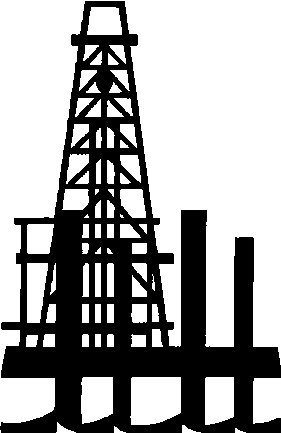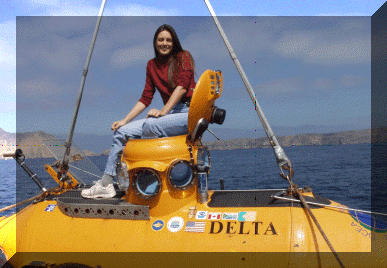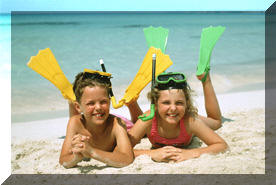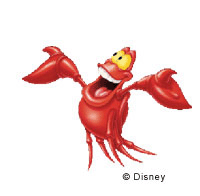MMS Pacific Region welcomes you to
Important information regarding child privacy.
Welcome, MMS OCEAN ENERGY EXPLORERS!
![]()
Did you know that oil can be found in the ocean floor?
 Some of this oil comes out of the ground through cracks in the earth that geologists
call natural oil seeps. Another way oil comes from the ocean floor is through drilling.
MMS' job is to watch over the oil companies as they drill for oil in the ocean and make
sure that they get the oil out of the ground safely. To do this, MMS has scientists,
engineers, and technicians to inspect how the oil gets out of the ground and to study the
surrounding ocean environment.
Some of this oil comes out of the ground through cracks in the earth that geologists
call natural oil seeps. Another way oil comes from the ocean floor is through drilling.
MMS' job is to watch over the oil companies as they drill for oil in the ocean and make
sure that they get the oil out of the ground safely. To do this, MMS has scientists,
engineers, and technicians to inspect how the oil gets out of the ground and to study the
surrounding ocean environment.
In the Pacific Ocean, off the coast of central and southern California, oil is being taken from the ocean floor every day. In fact, this area of the ocean is producing about 78,000 barrels of oil a day...that's a lot of oil!!!
Oil companies use big steel structures, called offshore platforms, to assist them in getting oil out from beneath the ocean floor. These platforms are like big skyscrapers or a mini city in the ocean. In the future, America may begin to explore renewable energy opportunities, such as harnessing energy from wind, waves, and currents, in our ocean environments. In fact, did you know that America is currently reviewing a proposal for the Nation's first offshore wind park?
Check out the sections in the Playground and learn about MMS - its scientists, offshore energy production, and our ocean environment - as well as how MMS works with students in the areas of science and math. In the Playground, you will find lots of pictures and an activities workbook called Petroleum and Our Environment.
![]()
|
Fun MMS Science Activities, Puzzles and Other Cool Stuff! |
|
  |
|
| National Energy Development (NEED) Project: Career Chat with a Biologist features an interview with MMS marine biologist Donna Schroeder. Reprint from CAREER CURRENTS, Dec. 2007/National Energy Development (NEED) Project. | |
|
|
Trying to compare
energy types is a challenge. The purpose of this project is to convert
various energy sources used in California into common units so that
they can be compared readily. The amount of space occupied by each
facility or unit is provided so that you can compare their land. These
assumptions and calculations for the numbers used in the bookmark are
provided in this paper.
Click here for
BOOKMARK
|
|
Explore ways to make Golden County energy self-sufficient through inquiry, cooperative problem-solving and negotiation. |
|
|
Ocean Energy Explore oil seeps,
currents, wave and wind energy, and drill for oil in the ocean.
|
|
|
|
Marine Archaeology California's history is very exciting, made of day-to-day events that start with the Native Americans and continue to this very day. |
 |
Petroleum and
Our Environment - Coloring and activities
workbook.
|
 |
The
Ocean's Sand, A Natural Resource
What is Sand and Gravel and why do we
need it for our beaches?
|
 |
Marine
Archaeology Study those places and objects that tell us how the early people of California used the sea. |
|
|
Visit the OHMSETT National Oil Spill Response Test Facility managed by the MMS
|
|
Download Acrobat Reader Free |
|
![]()
![]()
Other Energy and Ocean-related Kids' Sites:
 |
|
|
United States Science Support Program
|
Come visit Dr. E's Energy Lab! - DOE Energy Efficiency and Renewable Energy Website |
|
ROOFUS’ SOLAR AND EFFICIENT NEIGHBORHOOD
|
|
|
|
 Raise your
EQ (Energy Quest) at the California Energy Commission's website Raise your
EQ (Energy Quest) at the California Energy Commission's website |
|
Explore Energy with Energy Ant at the Department of Energy's Energy Information Administration Website |
Visit the Department of Energy's Kid's Zone |

MMS’s Energy Education Partner - National Energy Education Development |

Tap into the current Ocean Research at Scripps Institution of Oceanography |
|
|
|
![]()
| Did you know ...? | |
| What are the offshore platforms used for? | How big are the platforms? |
 The
offshore platforms are used to produce crude oil and natural gas from deep
beneath the sea floor. The
offshore platforms are used to produce crude oil and natural gas from deep
beneath the sea floor. |
Some platforms can weigh nearly 70,000 tons and are over 1,200 feet tall. That’s taller than the Empire State Building! Platform jackets, or the bottom of the platform hidden mostly beneath the ocean’s surface, weigh close to 43,000 tons – that’s about the weight of the Titanic! The smallest platform off the California coastline, called Platform Gina, weighs about 1100 tons. |
| Where is oil and natural gas found? | How do they get the oil and natural gas from the ground? |
| Oil and natural gas are found in the ground, trapped in layers of rock called deposits. There are different ways to find out where the oil and gas are deposited. After it is determined where a large deposit of oil and gas is, the area is often given a name and called a field. For example, the Ventura Avenue Field. | It’s not easy! First, they must drill a hole in the bottom of the sea floor. To drill for oil and gas, long sections of pipe are connected together with a bit at the end. A large steel tower called a drilling rig is used to connect the section of pipe together and rotate the pipe so that it can drill into the ground. For oil and gas deposits far from where the drilling rig is they use what is called directional drilling. Directional drilling is where you drill down into the earth and out into all different directions, finding oil and natural gas in different zones. Then they have to pump the oil, natural gas, and water out of the ground and onto the platform. |
| How do they get the platforms in the middle of the ocean? Do they float? | How does oil and natural gas help me? Why is it important to have oil and natural gas? |
| Men and women work very hard to build platforms that are going to stay in the ocean for sometimes over 20 years. The bottom portion of the platform, called the jacket, is built on land in a yard. The bottom is then placed on a boat called a barge and sailed out to the place in the ocean where they want to build a platform. Then, they hoist the bottom into the ocean. This is called a launch. The bottom of the platform then floats until they use a technique called control flooding to sink it into the ocean. They use large machines that act as hammers to drive it into the ground. Other pieces of the platform called the modules, or collectively the deck, are added to the bottom. These modules include production facilities, crew quarters, and a drilling rig. It’s a lot like putting Legos together! The platform is actually many different pieces put together to build one large functional platform. |
We use oil and natural gas to produce different forms of energy. Energy helps us to generate electricity, produce gasoline for our cars, heat our homes, and make many different plastic products like computers or video games. |
| Are there fish living on the platform? | Where does the oil and natural gas go after they’re taken from the ground? |
| Many fish live on the bottom of the platform, as well as sea lions on the bottom rungs of the platforms. Offshore platforms provide some of the most diverse habitats for sea life. Hard surfaces are homes to barnacles and mussels, while the underwater portion of the platforms serve as artificial reefs. | After being pumped from the ground, the oil and natural gas are put into pipelines that go to a processing facility so that they can be used for energy to heat our homes, provide us with electricity, fuel our cars, as well as many other uses. |
| Are the platforms safe? | How do the people get on and off the platform? |
|
|
There are two ways people get on and off the platforms, depending on which platform they’re at. Some board a boat which goes out to the platforms. Large cranes can then carry the people and equipment from the deck of the boat to the platforms 150 ft. onto the upper deck. Another way to get onto the platform from the boats is by a swing rope. Crew members and other visitors grab onto a long rope and swing onto the bottom of the platform. Another way to get to some of the platforms is by helicopter. The helicopter can actually land on the deck of the platform! |
| Do the crews on the platform live there? | How much oil and natural gas do we get from the offshore platforms? |
| The crews of the platforms don’t live there, yet they spend a great deal of time on the platforms! Crew members stay on the platform seven days at a time. They work 12 hour days, either day or night shift. After seven days, they are able to go home to their families for seven days. On most of the platforms, there’s a cafeteria, gym, TV and game room, bathrooms, showers, and sleeping quarters. | Twenty-three platforms are producing some 80,000 barrels of oil a day and about 145 million cubic feet of gas per day from 43 of the leases off the coast of Southern California. |
| What if the oil spills? How do they clean it up? | Do oil spills hurt the animals? |
| If an oil spill occurs, the platform crew members try to shutdown the source of the leak and then notify local, state, and federal agencies, including the Minerals Management Service. Companies such as Clean Seas and Marine Spill Response Corporation come in to respond to the incident with safety and specialized oil spill response equipment. The response teams first figure out if it is safe to clean up the spill and then use buoys to mark where exactly the spill has occurred in the water. Because oil floats on water, the response team uses a floating boom that acts like a wall to contain the oil in one location. Then, they use skimmers, or large brushes, to remove it from the water. The Minerals Management Service has an oil spill response research program that looks at new ways to clean up oil and improve methods we now have available. The Minerals Management Service reviews and approves the oil company’s oil spill response plan and conducts surprise oil spill drills. They also inspect their oil spill response equipment to make sure that they are prepared to respond to a spill. When practicing how to clean up an oil spill, they don’t actually put oil in the water. They simulate what an oil spill can look like using pads in the water so that the response team has a target to clean up. Between 1972 and 2000, U.S. Outer Continental Shelf offshore pipelines and facilities accounted for only 2 percent of the volume of oil spilled in U.S. waters. |
Oil spills affect different kinds of marine life, just as any man-made disaster affects the ecosystem. Animals like dolphins and whales are not bothered by oil, yet animals and organisms that live or spend much of their time on the surface of the water tend to be affected, such as birds who sleep on the water. Also, animals with fur, such as sea otters, can have trouble. There are many rehabilitation centers up and down the coast of California that help animals recover from occasional oil spills. |
| Are the offshore platforms just in California? | How many offshore platforms are there? |
| There are offshore platforms around the world! In the United States, there are offshore platforms off the coasts of California in the Pacific OCS Region and in the Gulf of Mexico OCS Region off the coasts of Louisiana, Alabama, Mississippi, and Texas. | There are more than 6,700 production platforms worldwide. Over 4,000 platforms are in the U.S. waters alone. Off America’s West Coast, there are 23 platforms that are producing oil and natural gas from 43 active leases on the Outer Continental Shelf in federal waters. The Outer Continental Shelf, or OCS, is the offshore coastal land beneath the ocean. |
| Does the government own the platforms? | I heard that fossil fuels are going to run out someday… is that true? |
| No, the government does not actually own the platforms. Oil and natural gas companies, such as Venoco, Aera, Nuevo, Arguello, POOLLC, and ExxonMobil own the platforms; the Minerals Management Service serves as a regulatory agency and makes sure the platforms are safe and working properly. Oil companies also pay MMS for the right to drill and produce oil and natural gas from the leases. MMS receives a royalty, or a portion of money made, from the oil companies. | Since oil and natural gas are not renewable energy sources, scientists predict that someday we will no longer have fossil fuels. However, many kinds of energy are being studied and used today, such as wind and tidal energy that are renewable. |
| What kind of people work on the platforms? Are they engineers? Scientists? | What is natural gas? Is it a gas, or is it a liquid like gasoline? |
| Many different kinds of people work on the platform. There are machinists who replace equipment, electricians who monitor all electrical systems, and technicians who replace parts. On many platforms, crew members share community responsibilities, such as making the meals. | Natural gas is a gas that is used to create products, such as gasoline. It is a mixture of hydrocarbon gases that occurs with petroleum deposits, principally methane together with varying quantities of ethane, propane, butane, and other gases, and is used as a fuel and in the manufacture of organic compounds. |
|
How do they find the oil and natural gas? Is it buried in the ocean? |
|
| Scientists work with engineers to design new ways to find oil and natural gas under the ocean’s sea floor. Millions of years ago, the coastal region was under water, part of a rich coastal ocean. Water was full of tiny plants called diotobes. After they died, they left behind microscopic skeletons which pilled up as a thick layer on the sea floor. As the years went by, mud and sand pilled on top of the organism remains, and because the sea floor heated up, the organic materials were pressurized and slowly changed into tar, oil, and natural gas. In the last few million years, the region has been in a slow-moving geological collision. Sea layers were shortened, wrinkled, and broken. Oil in rock layers were trapped under folds. Eventually, oil and tar escaped to the surface creating a natural seep. | |
![]()
Other MMS Regional Kids' Sites:
| Alaska Region | Gulf of Mexico Region | MMS Headquarters |
![]()
For more information:
John Romero,
Public Affairs Officer
U.S. Department of the Interior -
Minerals Management Service
770 Paseo Camarillo,
Camarillo, CA 93010
(805) 389-7533
![]()
| MMS Accessibility | MMS Quality of Information | MMS Privacy Policy | MMS Freedom of Information | MMS Disclaimer |
Web Master:
Nollie
Gildow-Owens
Page content last updated 7/30/2008
Page last published 7/30/2008












 Explore
Explore
 Learn about Geothermal Energy fr
Learn about Geothermal Energy fr


